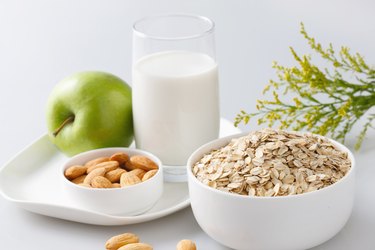
In 1877, oatmeal became the first breakfast cereal in the U.S. with a registered trademark, granted to Quaker Oats Company. By 1919, Malt-O-Meal cereal arrived as an oatmeal competitor in the hot cereal market. The company's original cereal used farina as its main component. Along with their original signature cereal product, the companies that produce Malt-O-Meal and oatmeal offer consumers multiple flavors and types under each brand.
Malt-O-Meal Features
Video of the Day
The Malt-O-Meal company extracts farina from wheat grains by grinding them. The resulting cereal has the texture of flour. When mixed with water or other liquids, farina becomes a smooth porridge.
Video of the Day
Oatmeal Features
Consumers have a choice of national and grocery oatmeal brands, all made from the grain of the oat plant. The main difference between retail varieties of oatmeal is the size of the oat flakes. The larger the oat flakes or pieces in the oatmeal, the longer the cooking time. Cutting the oats into small pieces produces quick oatmeal that cooks in five minutes. Instant oatmeal has the smallest flakes, and manufacturers often add salt to it.
Malt-O-Meal Macronutrients
Dry Malt-O-Meal has 145 calories in a 1/2-cup serving and provides 5 grams of protein, or 10 percent of the daily value for healthy adults. The carbohydrate content of 30 grams is 10 percent of the daily value. The fiber content is 2 grams, or 6 percent of your daily requirement. Malt-O-Meal has no cholesterol and contains less than 1 gram of fat.
Malt-O-Meal Minerals and Vitamins
This cereal's iron content is 16 milligrams per serving, or 88 percent of the daily value. It also has 151 milligrams of calcium, or 15 percent of the recommended daily intake. It provides 396 micrograms of folate, or 99 percent of the daily value. It contributes 0.7 milligrams of vitamin B-6 to your diet -- 37 percent of the daily value. The niacin content is 5 milligrams per serving, or 26 percent of the recommended intake. With less than 10 percent of the daily values, it is not a good source of any other vitamins and minerals.
Oatmeal Macronutrients
A 1/2-cup serving of oatmeal has 148 calories and 5 grams of protein, or 10 percent of the daily requirement. The carbohydrate content of 27 grams is 9 percent of the recommended daily intake. With 4 grams of fiber, this serving of oatmeal provides 19 percent of the daily value. Oatmeal contains no cholesterol, but this serving has 3 grams of fat, which is less than 5 percent of the daily value.
Oatmeal Minerals and Vitamins
The main mineral that oatmeal contributes to your diet is manganese. A serving has 2 milligrams, or 88 percent of the daily value. The 108 milligrams of magnesium is 27 percent of the daily value, and the 183 milligrams of phosphorus is 18 percent. The selenium content of 14 micrograms is 19 percent of the recommended daily intake. This serving has 2 milligrams of iron, or 10 percent of the daily value. Oatmeal has less than 10 percent of the recommended daily intake for other vitamins and minerals.